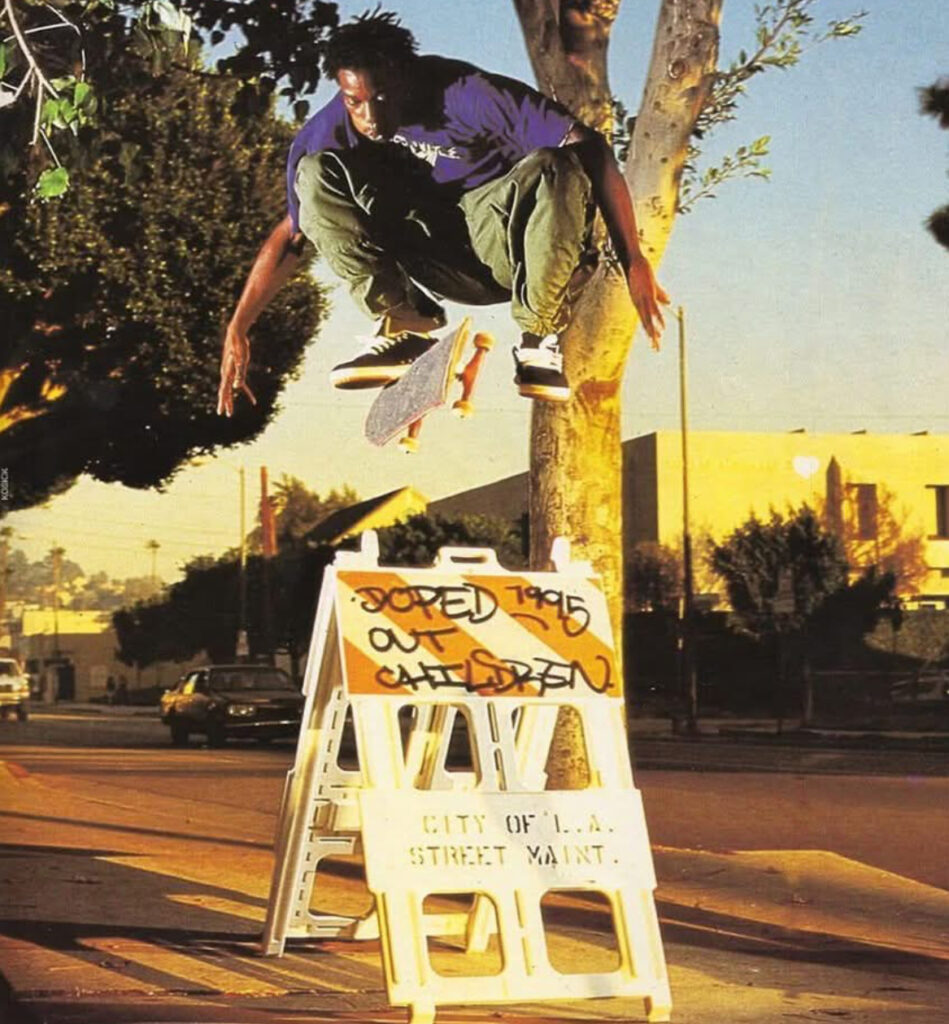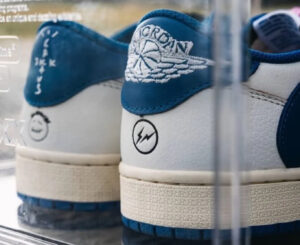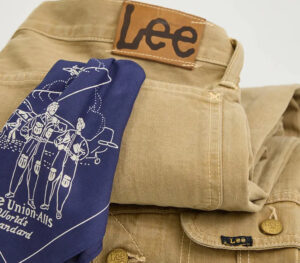Kareem Campbell, a name synonymous with style and innovation in skateboarding, experienced a career-defining transformation in 1995. Already recognized for his technical prowess and smooth approach to the sport, Campbell made a pivotal shift from vert skateboarding to street skating, a move that would shape his legacy and solidify his influence in skateboarding culture.
Beyond his technical achievements on the board, 1995 was also the year that Campbell expanded his presence beyond skateboarding, embracing entrepreneurship, fashion, and cultural impression. His ventures into skate footwear, business ownership, and fatherhood all contributed to a well-rounded career that would leave an indelible mark on skateboarding and streetwear culture.
The Shift to Street Skateboarding: A Pivotal Move
In the early 1990s, Campbell gained recognition as a vert skater, excelling in tricks on halfpipes and transition ramps. However, by 1995, street skateboarding was gaining dominance, and Campbell saw an opportunity to reinvent himself in this emerging discipline.
Street skateboarding was defined by technical tricks on urban obstacles like:
• Rails and ledges
• Stair sets and gaps
• Manual pads and curbs
Campbell embraced this change with confidence and originality, incorporating elements of his vert background into a more grounded, street-oriented style.
The Birth of the “Ghetto Bird”
One of Campbell’s most iconic contributions to skateboarding was his signature trick, the Ghetto Bird—a nollie hardflip followed by a 180-degree turn.
A highly technical trick that required precision and timing
Became a staple move in skateboarding trick history
Inspired generations of skaters to push technical limits
The Ghetto Bird exemplified Campbell’s unique approach, blending power, fluidity, and creativity. This trick, first showcased in 1995, cemented his reputation as a technical innovator in street skating.
Style and Technical Mastery
Campbell’s approach to skateboarding was described as smooth, stylish, and highly technical. He once stated:
“I go a lot bigger than most people. I like to skate anything technical and big—ledges, gaps, rails—that’s my forte.”
His ability to execute complex tricks with a relaxed, effortless flow made him stand out among his peers. By 1995, he had solidified his place among the greatest street skaters of his era.
Entrepreneurship: Axion Footwear and City Stars Skateboards
Founding Axion Footwear
1995 marked the beginning of Campbell’s entrepreneurial ventures, starting with the launch of Axion Footwear, a skate shoe brand that combined performance and style.
• Axion introduced technical features that enhanced durability and comfort.
• Campbell’s vision was to create a brand that reflected skateboarding’s growing influence on fashion.
• Axion’s success paved the way for skate shoes to blend functionality with streetwear aesthetics.
Campbell’s keen business sense helped Axion become a respected name in the skateboarding industry, later influencing modern skate brands like Nike SB, Adidas Skateboarding, and Puma Skate.
City Stars Skateboards: A Platform for Young Talent
In addition to Axion, Campbell founded City Stars Skateboards, a brand focused on mentorship and diversity in skateboarding.
Gave opportunities to young, talented skaters
Promoted inclusivity in a historically exclusive industry
Helped redefine skateboarding as a global culture
City Stars became a launchpad for many future professional skaters, solidifying Campbell’s role as a mentor and industry leader.
Cultural Influence: Skateboarding Meets Fashion
Skate Shoes and High Fashion Crossover
Campbell’s footwear influence extended beyond skateboarding. His signature shoes, along with those of fellow skateboarder Eric Koston, featured design elements inspired by brands like Jordan and Reebok.
• Blend of skate and basketball shoe aesthetics
• Introduced thick, padded tongues and ankle support
• Brought sneaker culture into the skateboarding world
These designs paved the way for high-end brands like Prada, A$AP Rocky’s AWGE, and Louis Vuitton to integrate skate-inspired elements into their footwear collections.
Influence on Streetwear
By combining skateboarding with hip-hop culture, Campbell became a fashion icon in the skate world. His signature style—baggy pants, oversized tees, and clean sneakers—became a template for street skaters of the late ’90s and early 2000s.
His look was emulated by an entire generation of skaters.
Major streetwear brands took inspiration from skate culture.
Skateboarding’s influence on hip-hop and mainstream fashion grew stronger.
Campbell’s stylistic choices and product connections helped shape the foundation of modern streetwear fashion.
Personal Milestones: Fatherhood and Legacy
Becoming a Father
1995 was also a transformative year in Campbell’s personal life. He became a father with the birth of his son, Kareem Jr., which added another dimension to his life.
Balanced skateboarding, business, and fatherhood.
Inspired by his role as a father, he built a legacy beyond skateboarding.
Continued to mentor young skaters and instill values of discipline and perseverance.
While many skaters struggled with the balance between career and personal life, Campbell thrived in both areas, setting an example for future generations.
Mainstream Exposure: Tony Hawk’s Pro Skater & Video Parts
Becoming a Playable Character in THPS
Campbell’s popularity skyrocketed when he became a playable character in Tony Hawk’s Pro Skater (THPS).
Introduced skateboarding to millions of gamers.
Showcased his signature tricks, including the Ghetto Bird.
Expanded his fanbase beyond traditional skateboarding audiences.
For many who had never stepped on a skateboard, THPS made Campbell a household name, reinforcing his influence in pop culture and gaming.
Iconic Skate Video Parts
Campbell was also featured in some of the most influential skateboarding videos of the 1990s, including:
• “New World Order” (1993) – Early showcase of his emerging street skills.
• “20 Shot Sequence” (1995) – Marked his full transition to street skating.
• “Trilogy” (1996) – A legendary video featuring his smooth, stylish approach.
These video parts documented his evolution, allowing fans to witness his growth, creativity, and impact on skateboarding.
The year 1995 was a turning point in Kareem Campbell’s career and life, marking his transformation into:
A pioneer of technical street skateboarding.
A successful entrepreneur with brands like Axion and City Stars.
A cultural icon influencing skateboarding fashion and streetwear.
A father, mentor, and role model for future generations.
His ability to blend style, innovation, and business acumen has left a lasting impact on skateboarding culture, inspiring countless skaters, entrepreneurs, and creatives to push boundaries and redefine what is possible.
As skateboarding continues to evolve, Campbell’s influence remains strong, proving that true legends never fade—they continue to inspire.
Focus Key Phrase: Kareem Campbell 1995 Skateboarding
Related Key Phrase: Kareem Campbell Street Skating Evolution
Synonyms: Legendary Skateboarder, Street Skateboarding Pioneer, Skateboarding Icon, 90s Skate Culture Influencer
120-Character Description: Kareem Campbell’s 1995 transformation to street skating, entrepreneurial success, and cultural impact shaped skate history.
Alt Text: Kareem Campbell mid-trick in 1995, showcasing his smooth and technical street skating style, influencing a generation of skaters.
Breadcrumb Title: Kareem Campbell 1995 – A Pivotal Year in Skateboarding History
No comments yet.








